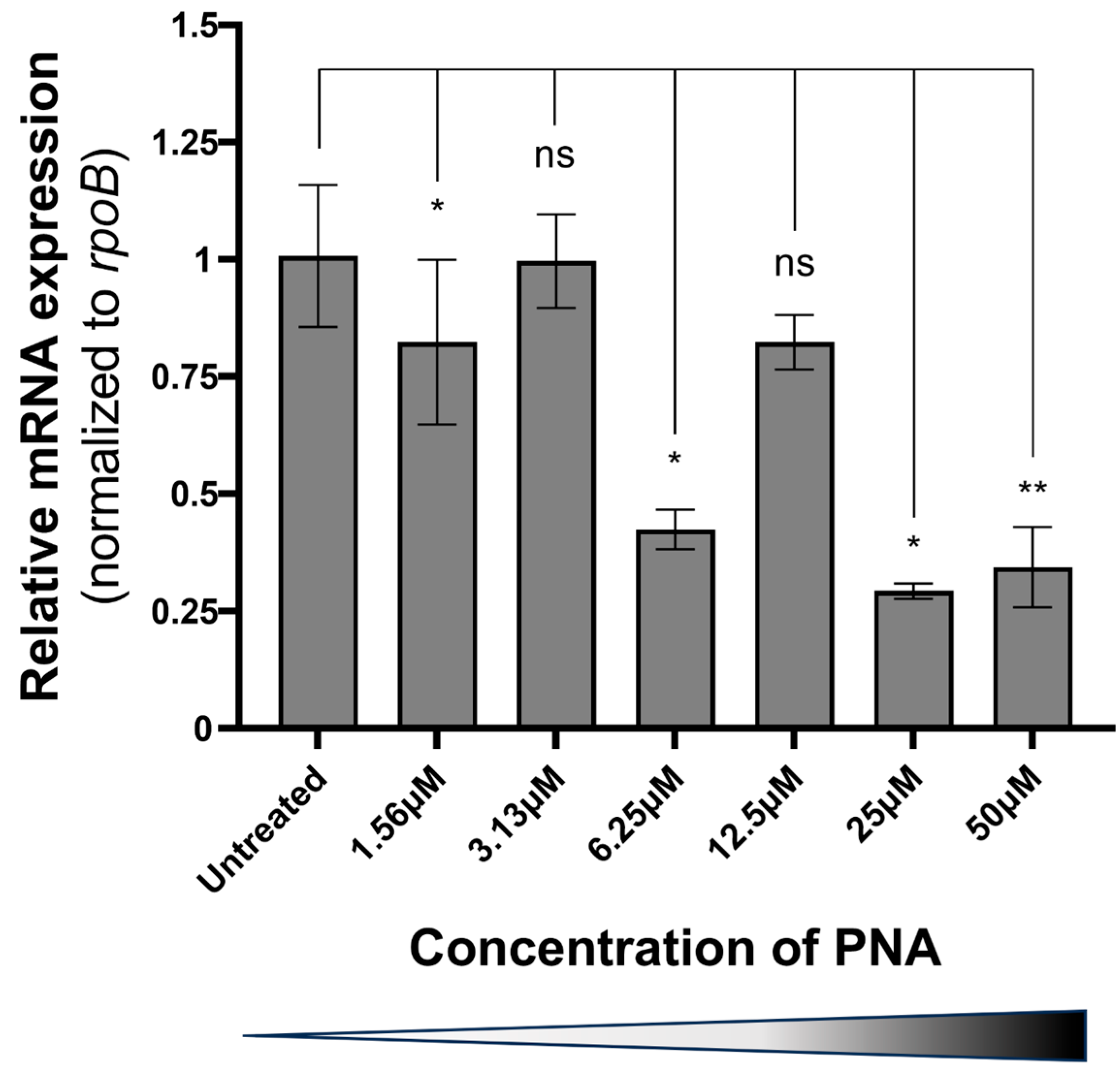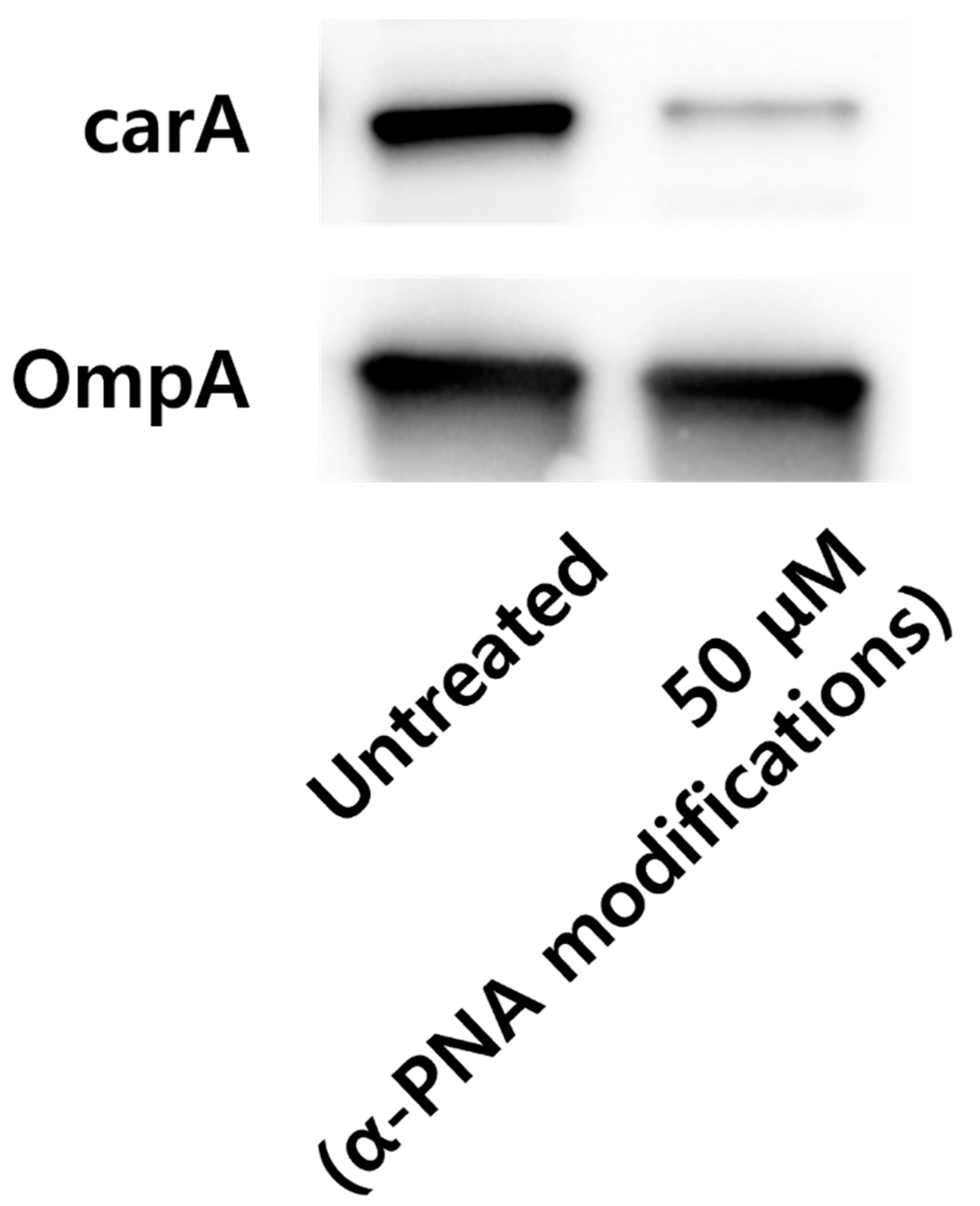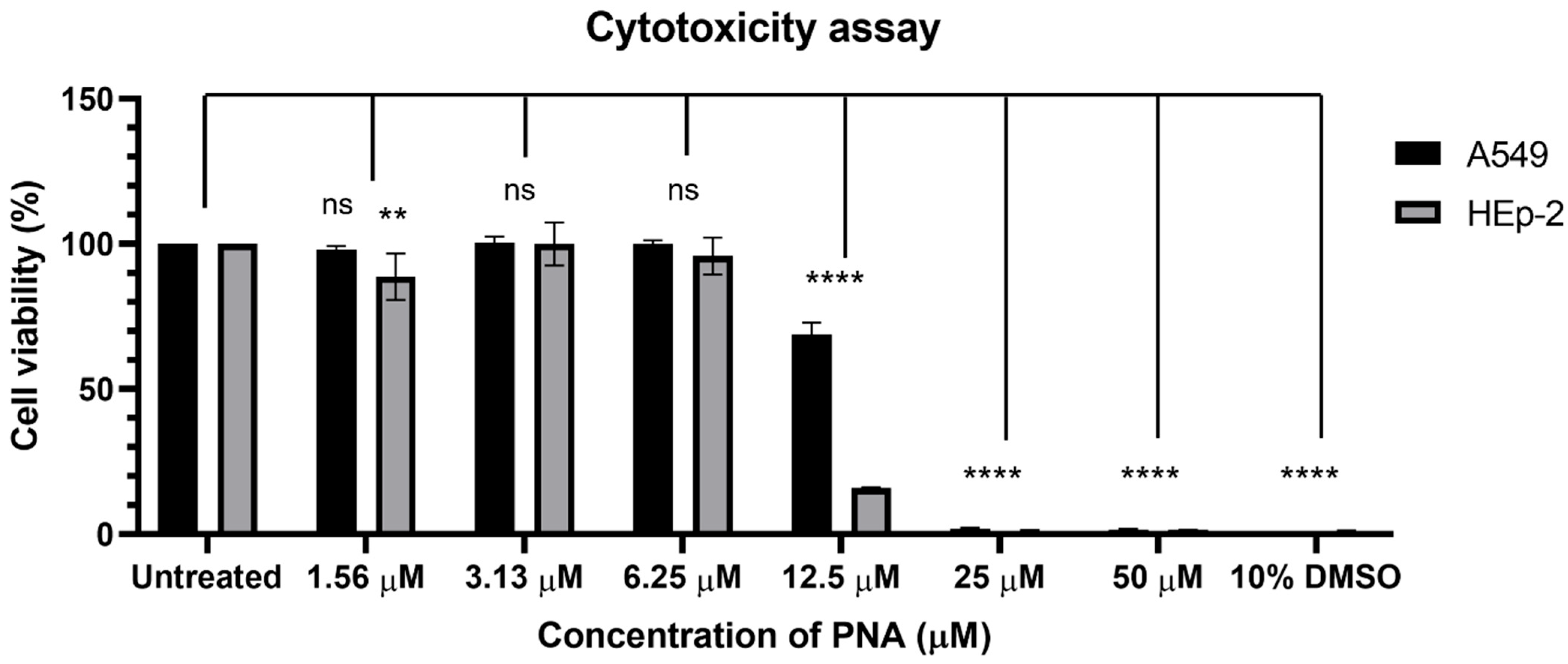Targeting carA Using Optimized Antisense Peptide Nucleic Acid–Cell-Penetrating Peptide Conjugates in Acinetobacter baumannii: A Novel Antibacterial Approach
Abstract
1. Introduction
2. Results
2.1. Inhibition of Bacterial Cell Growth by CPP–PNA Conjugates
2.2. Cytotoxicity of CPP–PNA Conjugates in Mammalian Cells
3. Discussion
4. Materials and Methods
4.1. MBC of CPP–PNA Conjugates for A. baumannii
4.2. MIC of Different CPP–PNA Conjugates for A. baumannii
4.3. qRT-PCR
4.4. Western Blotting
4.5. Evaluation of CPP–PNA Conjugate Cytotoxicity
4.6. Statistics and Reproducibility
5. Conclusions
Supplementary Materials
Author Contributions
Funding
Institutional Review Board Statement
Informed Consent Statement
Data Availability Statement
Conflicts of Interest
Abbreviations
| PNA | Peptide nucleic acid |
| CPP | Cell-penetrating peptide |
| α | Alpha |
| RBS | Ribosomal binding site |
| SDS–PAGE | Sodium dodecyl sulphate–polyacrylamide gel electrophoresis |
| TBS | Tryptic soy broth |
| MBC | Minimum bactericidal concentration |
| MIC | Minimum inhibitory concentration |
| MHB | Muller–Hinton broth |
| qRT-PCR | Quantitative real-time polymerase chain reaction |
| γ | Gamma |
References
- Lee, C.R.; Lee, J.H.; Park, M.; Park, K.S.; Bae, I.K.; Kim, Y.B.; Cha, C.J.; Jeong, B.C.; Lee, S.H. Biology of Acinetobacter baumannii: Pathogenesis, Antibiotic Resistance Mechanisms, and Prospective Treatment Options. Front. Cell Infect. Microbiol. 2017, 7, 55. [Google Scholar] [CrossRef]
- Alwazzeh, M.J.; Algazaq, J.; Al-Salem, F.A.; Alabkari, F.; Alwarthan, S.M.; Alhajri, M.; AlShehail, B.M.; Alnimr, A.; Alrefaai, A.W.; Alsaihati, F.H.; et al. Mortality and clinical outcomes of colistin versus colistin-based combination therapy for infections caused by Multidrug-resistant Acinetobacter baumannii in critically ill patients. BMC Infect. Dis. 2025, 25, 416. [Google Scholar] [CrossRef] [PubMed]
- Wojciechowska, M.; Równicki, M.; Mieczkowski, A.; Miszkiewicz, J.; Trylska, J. Antibacterial Peptide Nucleic Acids-Facts and Perspectives. Molecules 2020, 25, 559. [Google Scholar] [CrossRef]
- Sarkar, P.; Popella, L.; Pérez-Jiménez, S.; Vogel, J. RNA toehold switch-based reporter assay to assess bacterial uptake of antisense oligomers. mBio 2025, 16, e0398324. [Google Scholar] [CrossRef]
- Zhang, Y.; Røise, J.J.; Lee, K.; Li, J.; Murthy, N. Recent developments in intracellular protein delivery. Curr. Opin. Biotechnol. 2018, 52, 25–31. [Google Scholar] [CrossRef]
- El-Andaloussi, S.; Johansson, H.J.; Holm, T.; Langel, U. A novel cell-penetrating peptide, M918, for efficient delivery of proteins and peptide nucleic acids. Mol. Ther. 2007, 15, 1820–1826. [Google Scholar] [CrossRef] [PubMed]
- Choonara, B.F.; Choonara, Y.E.; Kumar, P.; Bijukumar, D.; du Toit, L.C.; Pillay, V. A review of advanced oral drug delivery technologies facilitating the protection and absorption of protein and peptide molecules. Biotechnol. Adv. 2014, 32, 1269–1282. [Google Scholar] [CrossRef]
- Geng, J.; Xia, X.; Teng, L.; Wang, L.; Chen, L.; Guo, X.; Belingon, B.; Li, J.; Feng, X.; Li, X.; et al. Emerging landscape of cell-penetrating peptide-mediated nucleic acid delivery and their utility in imaging, gene-editing, and RNA-sequencing. J. Control. Release 2022, 341, 166–183. [Google Scholar] [CrossRef] [PubMed]
- Kim, S.K.; Lee, J.B.; Lee, H.T.; Han, D.; Yoon, J.W. Development of antisense peptide-peptide nucleic acids against fluoroquinolone-resistant Escherichia coli. J. Antimicrob. Chemother. 2023, 78, 2052–2060. [Google Scholar] [CrossRef]
- Foged, C.; Nielsen, H.M. Cell-penetrating peptides for drug delivery across membrane barriers. Expert. Opin. Drug Deliv. 2008, 5, 105–117. [Google Scholar] [CrossRef]
- Timotievich, E.D.; Shilovskiy, I.P.; Khaitov, M.R. Cell-Penetrating Peptides as Vehicles for Delivery of Therapeutic Nucleic Acids. Mechanisms and Application in Medicine. Biochemistry 2023, 88, 1800–1817. [Google Scholar] [CrossRef]
- Ghosal, A.; Vitali, A.; Stach, J.E.; Nielsen, P.E. Role of SbmA in the uptake of peptide nucleic acid (PNA)-peptide conjugates in E. coli. ACS Chem. Biol. 2013, 8, 360–367. [Google Scholar] [CrossRef]
- Rose, M.; Lapuebla, A.; Landman, D.; Quale, J. In Vitro and In Vivo Activity of a Novel Antisense Peptide Nucleic Acid Compound Against Multidrug-Resistant Acinetobacter baumannii. Microb. Drug Resist. 2019, 25, 961–965. [Google Scholar] [CrossRef]
- El-Fateh, M.; Chatterjee, A.; Zhao, X. A systematic review of peptide nucleic acids (PNAs) with antibacterial activities: Efficacy, potential and challenges. Int. J. Antimicrob. Agents 2024, 63, 107083. [Google Scholar] [CrossRef] [PubMed]
- Good, L.; Awasthi, S.K.; Dryselius, R.; Larsson, O.; Nielsen, P.E. Bactericidal antisense effects of peptide-PNA conjugates. Nat. Biotechnol. 2001, 19, 360–364. [Google Scholar] [CrossRef] [PubMed]
- Yavari, N.; Goltermann, L.; Nielsen, P.E. Uptake, Stability, and Activity of Antisense Anti-acpP PNA-Peptide Conjugates in Escherichia coli and the Role of SbmA. ACS Chem. Biol. 2021, 16, 471–479. [Google Scholar] [CrossRef]
- Lee, H.M.; Ren, J.; Tran, K.M.; Jeon, B.M.; Park, W.U.; Kim, H.; Lee, K.E.; Oh, Y.; Choi, M.; Kim, D.S.; et al. Identification of efficient prokaryotic cell-penetrating peptides with applications in bacterial biotechnology. Commun. Biol. 2021, 4, 205. [Google Scholar] [CrossRef] [PubMed]
- Bai, H.; You, Y.; Yan, H.; Meng, J.; Xue, X.; Hou, Z.; Zhou, Y.; Ma, X.; Sang, G.; Luo, X. Antisense inhibition of gene expression and growth in gram-negative bacteria by cell-penetrating peptide conjugates of peptide nucleic acids targeted to rpoD gene. Biomaterials 2012, 33, 659–667. [Google Scholar] [CrossRef]
- Oikawa, K.; Islam, M.M.; Horii, Y.; Yoshizumi, T.; Numata, K. Screening of a Cell-Penetrating Peptide Library in Escherichia coli: Relationship between Cell Penetration Efficiency and Cytotoxicity. ACS Omega 2018, 3, 16489–16499. [Google Scholar] [CrossRef]
- Nejad, A.J.; Shahrokhi, N.; Nielsen, P.E. Targeting of the Essential acpP, ftsZ, and rne Genes in Carbapenem-Resistant Acinetobacter baumannii by Antisense PNA Precision Antibacterials. Biomedicines 2021, 9, 429. [Google Scholar] [CrossRef]
- Sahu, B.; Chenna, V.; Lathrop, K.L.; Thomas, S.M.; Zon, G.; Livak, K.J.; Ly, D.H. Synthesis of conformationally preorganized and cell-permeable guanidine-based gamma-peptide nucleic acids (gammaGPNAs). J. Org. Chem. 2009, 74, 1509–1516. [Google Scholar] [CrossRef]
- MacLelland, V.; Kravitz, M.; Gupta, A. Therapeutic and diagnostic applications of antisense peptide nucleic acids. Mol. Ther. Nucleic Acids 2024, 35, 102086. [Google Scholar] [CrossRef]
- Brodyagin, N.; Katkevics, M.; Kotikam, V.; Ryan, C.A.; Rozners, E. Chemical approaches to discover the full potential of peptide nucleic acids in biomedical applications. Beilstein J. Org. Chem. 2021, 17, 1641–1688. [Google Scholar] [CrossRef] [PubMed]
- Goltermann, L.; Yavari, N.; Zhang, M.; Ghosal, A.; Nielsen, P.E. PNA Length Restriction of Antibacterial Activity of Peptide-PNA Conjugates in Escherichia coli Through Effects of the Inner Membrane. Front. Microbiol. 2019, 10, 1032. [Google Scholar] [CrossRef] [PubMed]
- Ferreira, M.B.; Myiagi, S.; Nogales, C.G.; Campos, M.S.; Lage-Marques, J.L. Time- and concentration-dependent cytotoxicity of antibiotics used in endodontic therapy. J. Appl. Oral. Sci. 2010, 18, 259–263. [Google Scholar] [CrossRef] [PubMed]
- Zakeri-Milani, P.; Najafi-Hajivar, S.; Sarfraz, M.; Nokhodchi, A.; Mohammadi, H.; Montazersaheb, S.; Niazi, M.; Hemmatzadeh, M.; Soleymani-Goloujeh, M.; Baradaran, B.; et al. Cytotoxicity and Immunogenicity Evaluation of Synthetic Cell-penetrating Peptides for Methotrexate Delivery. Iran. J. Pharm. Res. 2021, 20, 506–515. [Google Scholar] [CrossRef]
- Cardozo, A.K.; Buchillier, V.; Mathieu, M.; Chen, J.; Ortis, F.; Ladrière, L.; Allaman-Pillet, N.; Poirot, O.; Kellenberger, S.; Beckmann, J.S.; et al. Cell-permeable peptides induce dose- and length-dependent cytotoxic effects. Biochim. Biophys. Acta 2007, 1768, 2222–2234. [Google Scholar] [CrossRef]
- Morris, M.C.; Gros, E.; Aldrian-Herrada, G.; Choob, M.; Archdeacon, J.; Heitz, F.; Divita, G. A non-covalent peptide-based carrier for in vivo delivery of DNA mimics. Nucleic Acids Res. 2007, 35, e49. [Google Scholar] [CrossRef]
- Martínez-Guitián, M.; Vázquez-Ucha, J.C.; Álvarez-Fraga, L.; Conde-Pérez, K.; Bou, G.; Poza, M.; Beceiro, A. Antisense inhibition of lpxB gene expression in Acinetobacter baumannii by peptide-PNA conjugates and synergy with colistin. J. Antimicrob. Chemother. 2020, 75, 51–59. [Google Scholar] [CrossRef]



| CPP Sequence | PNA Sequence | MBC (CFU) in 50 µM CPP–PNA | Average CFU |
|---|---|---|---|
| KFFK(FFK)2 | TCAAACCAAAGCT | 0 | 0 |
| TCAAACCAAAGCT | 0 | ||
| KKFK(FFK)2 | TCAAACCAAAGCT | 7 | 10.5 |
| TCAAACCAAAGCT | 14 | ||
| KKKK(FFK)2 | TCAAACCAAAGCT | TNTC | TNTC |
| TCAAACCAAAGCT | TNTC |
| Gene Target Region | CPP | PNA Sequence | PNA Length (mer) | MIC (μM) | Modification |
|---|---|---|---|---|---|
| carA (RBS) | KFFK(FFK)2 | TCAAACCAAAGCT | 13 | 25 | - |
| carA (Start codon) | KFFK(FFK)2 | CGGGGGTGCTCAA | 13 | >50 | - |
| carA (Stop codon) | KFFK(FFK)2 | TTACTGTTTAGAT | 13 | 50 | - |
| carA (RBS) | KFFK(FFK)2 | TCAAA*CCA*AAGCT | 13 | 25 | γ |
| carA (RBS) | KFFK(FFK)2 | TCAAA^CCA^AAGCT | 13 | 12.5 | α |
| carA (RBS) | KFFK(FFK)2 | AAC^CAAA^GCT | 10 | 6.25 | α |
| Control 1 (mismatch) | KFFK(FFK)2 | ACC^CACA^GCT | 10 | 12.5 | α |
| Control 2 (mismatch) | KFFK(FFK)2 | ACC^CACA^CCC | 10 | 12.5 | α |
| Control 3 (acpP) | KFFK(FFK)2 | TGATTTGCCAC | 10 | 25 | |
| Control 4 (ftsZ) | KFFK(FFK)2 | GAGGCCATGAC | 10 | 50 | |
| Control 5 (rne) | KFFK(FFK)2 | ACGTTTCATGG | 10 | 50 |
| Gene Target Region | CPP | PNA Sequence | MIC (μM) | ||
|---|---|---|---|---|---|
| Escherichia coli ATCC 25922 | Staphylococcus aureus ATCC 29213 | Pseudomonas aerusinosa ATCC 27853 | |||
| carA (RBS) | KFFK(FFK)2 | AAC^CAAA^GCT | >50 | >50 | 50 |
| Primer Name | Oligonucleotide Sequence (5′ to 3′) | Reference |
|---|---|---|
| CPP–PNA-F (carA) | GGTCTGAAGGTTCATGGGTATT | This study |
| CPP–PNA-R (carA) | GCAGGGACAACAGTGAGTTTA | This study |
| rpoB-F | TGACTCTGGTGTGTGTGTAATC | This study |
| rpoB-R | CACCTGCAACCATTTCATCTTC | This study |
Disclaimer/Publisher’s Note: The statements, opinions and data contained in all publications are solely those of the individual author(s) and contributor(s) and not of MDPI and/or the editor(s). MDPI and/or the editor(s) disclaim responsibility for any injury to people or property resulting from any ideas, methods, instructions or products referred to in the content. |
© 2025 by the authors. Licensee MDPI, Basel, Switzerland. This article is an open access article distributed under the terms and conditions of the Creative Commons Attribution (CC BY) license (https://creativecommons.org/licenses/by/4.0/).
Share and Cite
Seo, J.-H.; Kim, Y.-J.; Jeon, W.-J.; Yoo, J.-S.; Moon, D.-C. Targeting carA Using Optimized Antisense Peptide Nucleic Acid–Cell-Penetrating Peptide Conjugates in Acinetobacter baumannii: A Novel Antibacterial Approach. Int. J. Mol. Sci. 2025, 26, 9526. https://doi.org/10.3390/ijms26199526
Seo J-H, Kim Y-J, Jeon W-J, Yoo J-S, Moon D-C. Targeting carA Using Optimized Antisense Peptide Nucleic Acid–Cell-Penetrating Peptide Conjugates in Acinetobacter baumannii: A Novel Antibacterial Approach. International Journal of Molecular Sciences. 2025; 26(19):9526. https://doi.org/10.3390/ijms26199526
Chicago/Turabian StyleSeo, Ju-Hui, Yoo-Jeong Kim, Wook-Jong Jeon, Jung-Sik Yoo, and Dong-Chan Moon. 2025. "Targeting carA Using Optimized Antisense Peptide Nucleic Acid–Cell-Penetrating Peptide Conjugates in Acinetobacter baumannii: A Novel Antibacterial Approach" International Journal of Molecular Sciences 26, no. 19: 9526. https://doi.org/10.3390/ijms26199526
APA StyleSeo, J.-H., Kim, Y.-J., Jeon, W.-J., Yoo, J.-S., & Moon, D.-C. (2025). Targeting carA Using Optimized Antisense Peptide Nucleic Acid–Cell-Penetrating Peptide Conjugates in Acinetobacter baumannii: A Novel Antibacterial Approach. International Journal of Molecular Sciences, 26(19), 9526. https://doi.org/10.3390/ijms26199526









